
FM 21-150 COMBATIVES 1992
.pdf
FM 21-150
(6) High No. 5 angle of defense. The attacker lunges with a thrust to the face, throat, or solar plexus (Figure 5-18, Step 1).
The defender moves his body off the line of attack while parrying with either hand. He redirects the attacking arm so that the knife clears his body (Figure 5-18, Step 2).
He maintains control of the weapon hand or arm and gouges the eyes of the attacker, driving him backward and off balance (Figure 5-18, Step 3). If the attacker is much taller than the defender, it may be a more natural movement for the defender to raise his left hand to strike and deflect the attacking arm. He can then gouge his thumb or fingers into the jugular notch of the attacker and force him to the ground.
Still another possibility for a high No. 5 angle of attack is for the defender to move his body off the line of attack while parrying. He can then turn his body, rotate his shoulder under the elbow joint of the attacker, and lock it out (Figure 5-18, Step 4).
5-28
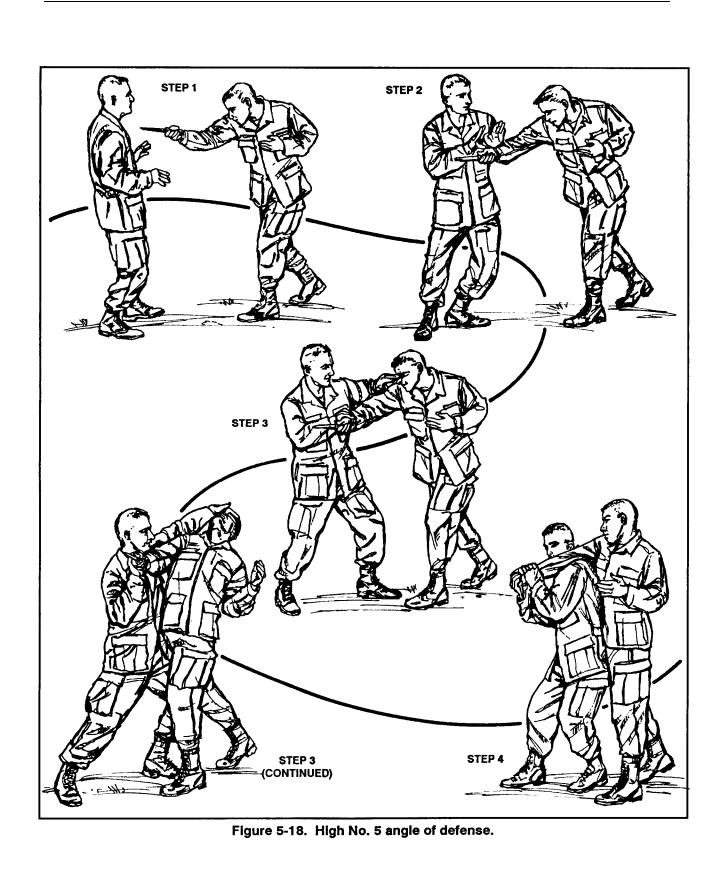
FM 21-150
5-29
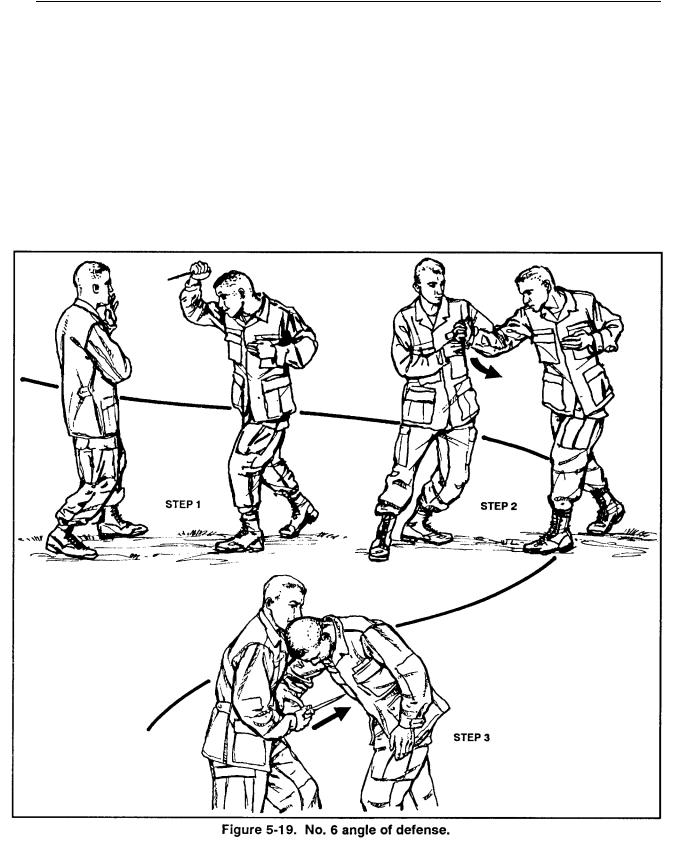
FM 21-150
(7) No. 6 angle of defense. The attacker strikes straight downward onto the defender with a stab (Figure 5-19, Step 1).
The defender reacts by moving his body out of the weapon’s path and by parrying or checking and redirecting the attacking arm, as the movement in the high No. 5 angle of defense (Figure 5-19, Step 2). The reactions may vary as to what is natural for the defender.
The defender then takes control of the weapon and disarms the attacker (Figure 5-19, Step 3).
5-30

FM 21-150
c. Follow-Up Techniques. Once the instructor believes the soldiers are skilled in these basic reactions to attack, follow-up techniques may be introduced and practiced. These drills make up the defense possibilities against the various angles of attack. They also enable the soldier to apply the principles of defense against weapons and allow him to feel the movements. Through repetition, the reactions become natural, and the soldier instinctively reacts to a knife attack with the proper defense. It is important not to associate specific movements or techniques with certain types of attack. The knife fighter must rely on his knowledge of principles and his training experience in reacting to a knife attack. No two attacks or reactions will be the same; thus, memorizing techniques will not ensure a soldier’s survival.
(1) Defend and clear. When the defender has performed a defensive maneuver and avoided an attack, he can push the attacker away and move out of the attacker’s reach.
(2)Defend and stun. After the defender performs his first defensive maneuver to a safer position, he can deliver a stunning blow as an immediate counterattack. Strikes to motor nerve points or attacker’s limbs, low kicks, and elbow strikes are especially effective stunning techniques.
(3)Defend and disarm. The defender also follows up his first defensive maneuver by maintaining control of the attacker’s weapon arm, executing a stunning technique, and disarming the attacker. The stun distracts the attacker and also gives the defender some time to gain possession of the weapon and to execute his disarming technique.
5-6. UNARMED DEFENSE AGAINST A RIFLE
WITH FIXED BAYONET
Defense against a rifle with a fixed bayonet involves the same principles as knife defense. The soldier considers the same angles of attack and the proper response for any attack along each angle.
a.Regardless of the type weapon used by the enemy, his attack will always be along one of the nine angles of attack at any one time. The soldier must get his entire body off the line of attack by moving to a safe position. A rifle with a fixed bayonet has two weapons: a knife at one end and a butt stock at the other end. The soldier will be safe as long as he is not in a position where he can be struck by either end during the attack.
b.Usually, he is in a more advantageous position if he moves inside the length of the weapon. He can then counterattack to gain control of the situation as soon as possible. The following counterattacks can be used as defenses against a rifle with a fixed bayonet; they also provide a good basis for training.
5-31

FM 21-150
(1) Unarmed defense against No. 1 angle of attack. The attacker prepares to slash along the No. 1 angle of attack (Figure 5-20, Step 1).
The defender waits until the last possible moment before moving so he is certain of the angle along which the attack is directed (Figure 5-20, Step 2). This way, the attacker cannot change his attack in response to movement by the defender.
When the defender is certain that the attack is committed along a specific angle (No. 1, in this case), he moves to the inside of the attacker and gouges his eyes (Figure 5-20, Step 2) while the other hand redirects and controls the weapon. He maintains control of the weapon and lunges his entire body weight into the eye gouge to drive the attacker backward and off balance. The defender now ends up with the weapon, and the attacker is in a poor recovery position (Figure 5-20, Step 3).
5-32
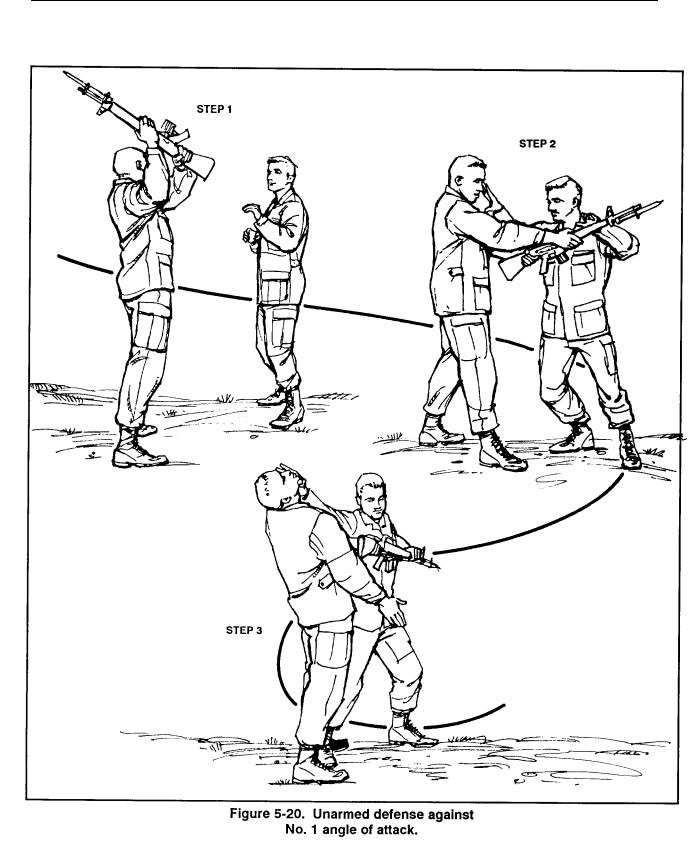
FM 21-150
5-33

FM 21-150
(2) Unarmed defense against No. 2 angle of attack. The attacker makes a diagonal slash along the No. 2 angle of attack (Figure 5-21, Step 1). Again, the defender waits until he is sure of the attack before moving.
The defender then moves to the outside of the attacker and counterattacks with a thumb jab into the right armpit (Figure 5-21, Step 2). He receives the momentum of the attacking weapon and controls it with his free hand.
He uses the attacker’s momentum against him by pulling the weapon in the direction it is going with one hand and pushing with his thumb of the other hand (Figure 5-21, Step 3). The attacker is completely off balance, and the defender can gain control of the weapon.
5-34
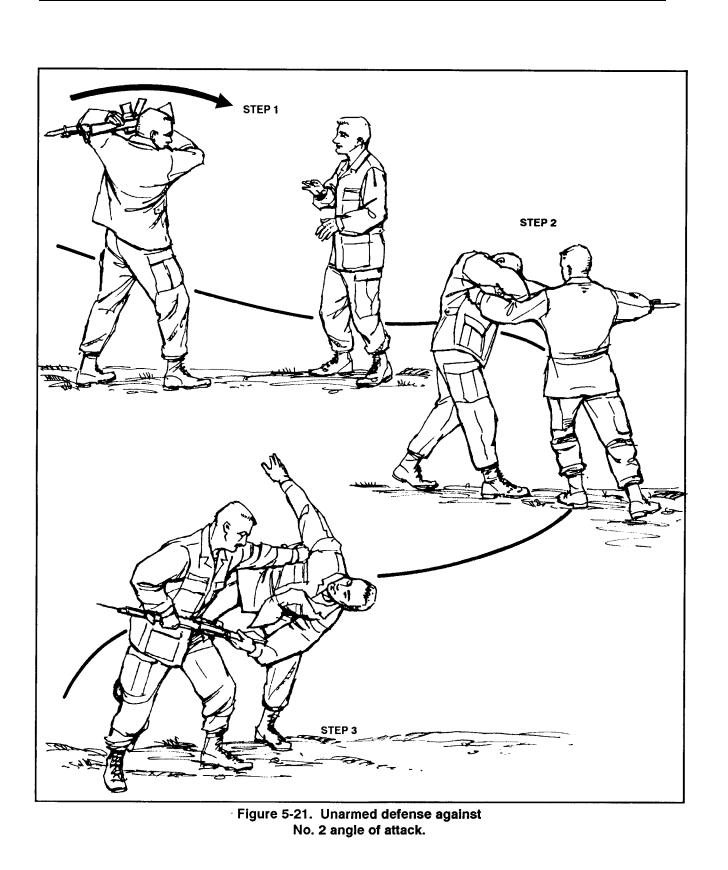
FM 21-150
5-35
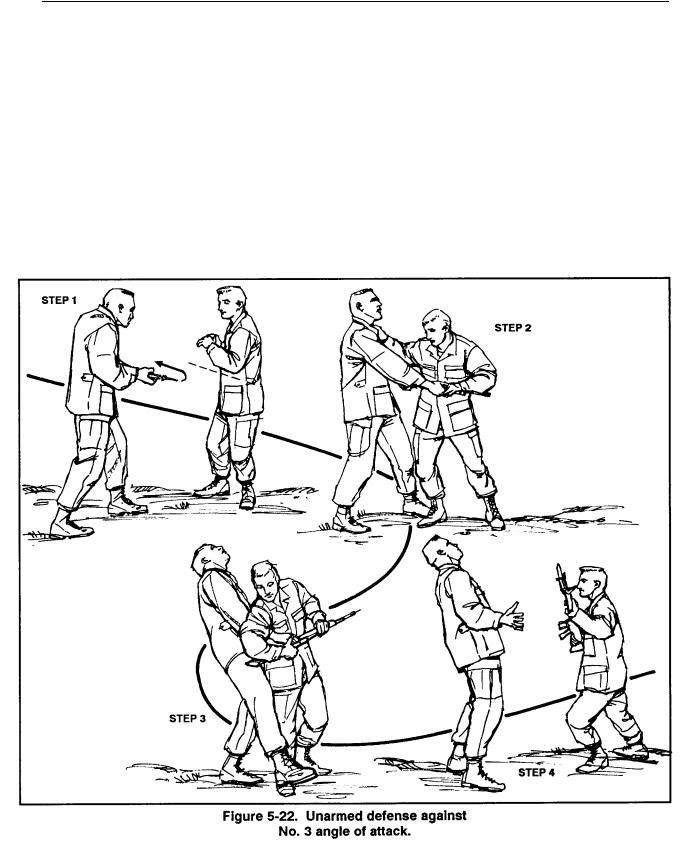
FM 21-150
(3) Unarmed defense against No. 3 angle of attack. The attacker directs a horizontal slash along the No. 3 angle of attack (Figure 5-22, Step 1).
The defender turns and moves to the inside of the attacker; he then strikes with his thumb into the jugular notch (Figure 5-22, Step 2).
His entire body mass is behind the thumb strike and, coupled with the incoming momentum of the attacker, the strike drives the attacker’s head backward and takes his balance (Figure 5-22, Step 3).
The defender turns his body with the momentum of the weapon’s attack to strip the weapon from the attacker’s grip (Figure 5-22, Step 4).
5-36
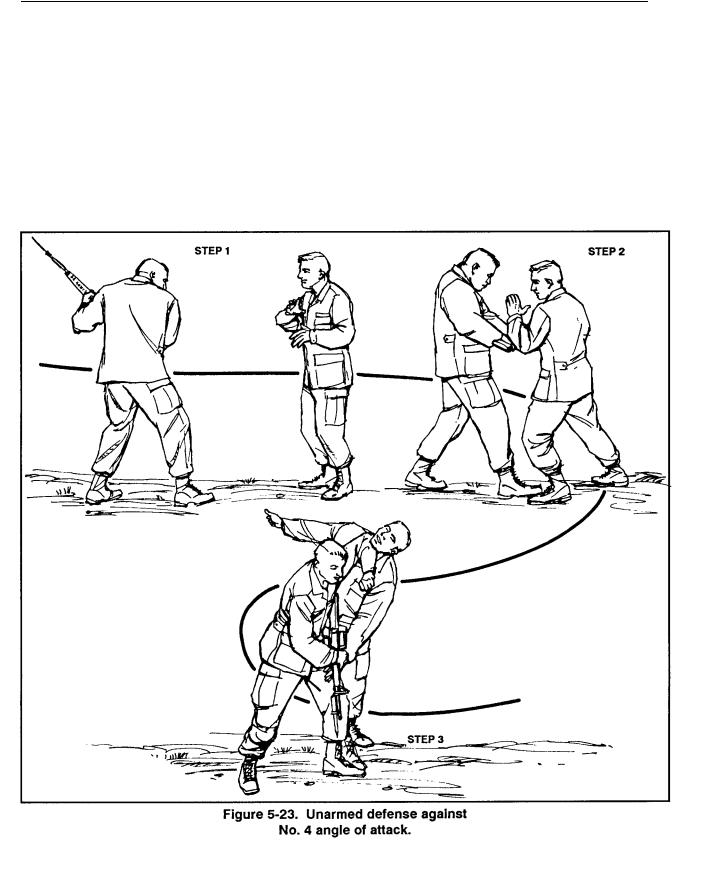
FM 21-150
(4) Unarmed defense against No. 4 angle of attack. The attack is a horizontal slash along the No. 4 angle of attack (Figure 5-23, Step 1).
The defender moves into the outside of the attacker (Figure 5-23, Step 2).
He then turns with the attack, delivering an elbow strike to the throat (Figure 5-23, Step 3). At the same time, the defender’s free hand controls the weapon and pulls it from the attacker as he is knocked off balance from the elbow strike.
5-37
